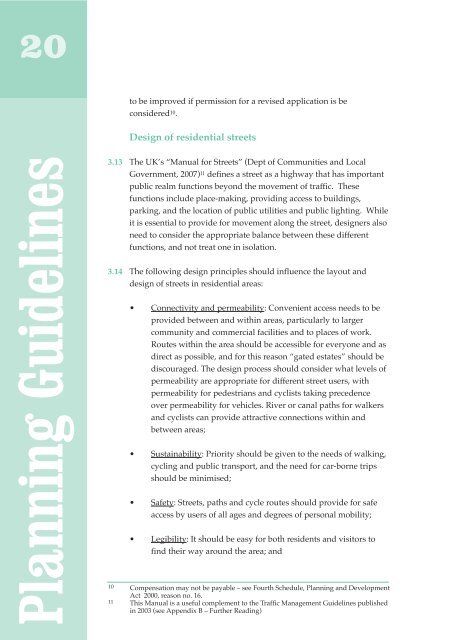Sustainable Residential Development in Urban Areas
Sustainable Residential Development in Urban Areas
Sustainable Residential Development in Urban Areas
Create successful ePaper yourself
Turn your PDF publications into a flip-book with our unique Google optimized e-Paper software.
20<br />
Plann<strong>in</strong>g Guidel<strong>in</strong>es<br />
to be improved if permission for a revised application is be<br />
considered 10.<br />
Design of residential streets<br />
3.13 The UK’s “Manual for Streets” (Dept of Communities and Local<br />
Government, 2007) 11 def<strong>in</strong>es a street as a highway that has important<br />
public realm functions beyond the movement of traffic. These<br />
functions <strong>in</strong>clude place-mak<strong>in</strong>g, provid<strong>in</strong>g access to build<strong>in</strong>gs,<br />
park<strong>in</strong>g, and the location of public utilities and public light<strong>in</strong>g. While<br />
it is essential to provide for movement along the street, designers also<br />
need to consider the appropriate balance between these different<br />
functions, and not treat one <strong>in</strong> isolation.<br />
3.14 The follow<strong>in</strong>g design pr<strong>in</strong>ciples should <strong>in</strong>fluence the layout and<br />
design of streets <strong>in</strong> residential areas:<br />
• Connectivity and permeability: Convenient access needs to be<br />
provided between and with<strong>in</strong> areas, particularly to larger<br />
community and commercial facilities and to places of work.<br />
Routes with<strong>in</strong> the area should be accessible for everyone and as<br />
direct as possible, and for this reason “gated estates” should be<br />
discouraged. The design process should consider what levels of<br />
permeability are appropriate for different street users, with<br />
permeability for pedestrians and cyclists tak<strong>in</strong>g precedence<br />
over permeability for vehicles. River or canal paths for walkers<br />
and cyclists can provide attractive connections with<strong>in</strong> and<br />
between areas;<br />
• Susta<strong>in</strong>ability: Priority should be given to the needs of walk<strong>in</strong>g,<br />
cycl<strong>in</strong>g and public transport, and the need for car-borne trips<br />
should be m<strong>in</strong>imised;<br />
• Safety: Streets, paths and cycle routes should provide for safe<br />
access by users of all ages and degrees of personal mobility;<br />
• Legibility: It should be easy for both residents and visitors to<br />
f<strong>in</strong>d their way around the area; and<br />
10 Compensation may not be payable – see Fourth Schedule, Plann<strong>in</strong>g and <strong>Development</strong><br />
Act 2000, reason no. 16.<br />
11 This Manual is a useful complement to the Traffic Management Guidel<strong>in</strong>es published<br />
<strong>in</strong> 2003 (see Appendix B – Further Read<strong>in</strong>g)

















